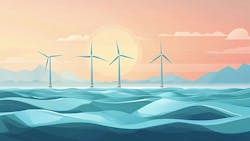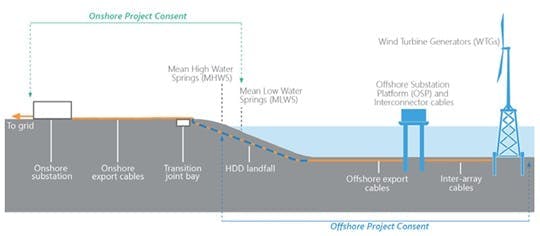Study to assess implications of potential UK offshore wind farms congestion
The University of Manchester in northwest England is leading a 12-month research project to refine understanding of the potential energy yield from offshore wind in UK waters.
POUNDS (prediction of unqualified losses from offshore wind farm wakes) will deliver a UK-wide assessment of interactions between current and planned wind farms.
The UK government is targeting 43-50 GW of installed offshore wind capacity by 2030. Currently 16 GW is in operation with other projects under development following the recent Contract for Difference Allocations to support pricing.
However, the 2030 goal will require a major increase in capacity, which could exceed 100 GW by 2050.
The expansion plans mean that the wind farms will need to be constructed closer together. POUNDS will examine how this affects predictions of annual energy production.
Large groups of turbines built in close proximity create ‘wakes’ where wind slows down behind them. According to the project team, wakes have been observed extending out to 65 km and are increasingly impacting the efficiency of turbines at neighboring wind farms.
The situation could lead to conflicts between wind farm operators.
POUNDS, which has funding from the Engineering and Physical Science Research Council (EPSRC) Supergen Offshore Renewable Energy Impact Hub, will be conducted with various UK Offshore Renewable Energy (ORE) institutes, consultants, developers and others, such as ORE Catapult, Arup, EDF, RWE and The Crown Estate.
The main goals are to:
- Assess how offshore wind farms affect each other’s energy production, and the revenue implications.
- Help determine optimum locations for future offshore wind farms to minimize these losses.
- Validate modeled performance data against operational data.
- Improve model accuracy in forecasting wind farm energy production.
The project teams will use mesoscale numerical weather forecasting models to model performance of wind farms across UK waters at a resolution of 1 km; both of those are currently operational and the others to follow by 2030.
The analysis will evaluate accuracy of the model against real-world data and quantify the impact of inter-farm wakes on predicted energy yield.
West of Orkney Windfarm continues progress
In northern Scotland, the Highland Council has declared its support for the joint venture’s offshore plans for the West of Orkney Windfarm development, 30 km west of the Orkney Islands and 25 km north of the Sutherland coat on mainland Scotland.
The consortium of Corio Generation, TotalEnergies and Renewable Infrastructure Development Group (RIDG) plans to commission up to 125 wind turbines on fixed foundations providing up to 2 GW of power by 2030.
Scotland’s government will take the final decision on the offshore consent, based on recommendations by the Marine Directorate Licensing Operations Team (MD-LOT) and others.
West of Orkney Windfarm development manager Jack Farnham said, “This paves the way to full offshore consent, which—if secured—would enable us to enter into a forthcoming UK ‘contract for difference’ auction round, which is a vital step in the advancement of both the project and its supply chain.”
UK invests $71M in Scottish port expansion
The UK government has awarded more than £55 million (US$71.1 million) to Port of Cromarty Firth in a boost to secure critical facilities needed for the development of new floating offshore wind farms and ensure they are built from the UK, according to a March 5 news release.
The Department for Energy Security and Net Zero confirmed the Floating Offshore Wind Manufacturing Investment Scheme (FLOWMIS) funding for the Invergordon-based Trust Port’s Phase 5 expansion, which aims to establish the UK’s first custom-built integration hub for floating offshore windfarm construction.
Port of Cromarty Firth aims to secure match-funding from banks and/or other investors, and to award a pre-construction contract to start work on Phase 5, which must be completed in 2027 to be ready for the first commercial-scale floating wind projects.
The expansion project is expected to create 170 to 320 jobs in the construction phase. When complete, it will provide the larger facilities needed for the construction, installation and operational support to offshore and floating offshore wind.
Related content: Offshore wind and the problem of global stilling
The phenomenon of “global terrestrial stilling” may pose a significant reality check on the offshore wind industry. The effects of this phenomenon can be seen in recent “wind droughts” that have impacted Europe and the UK in recent years.
Subscribe to Offshore's YouTube channel to stay updated on the latest technologies and trends of the offshore energy industry.
About the Author
Jeremy Beckman
Editor, Europe
Jeremy Beckman has been Editor Europe, Offshore since 1992. Prior to joining Offshore he was a freelance journalist for eight years, working for a variety of electronics, computing and scientific journals in the UK. He regularly writes news columns on trends and events both in the NW Europe offshore region and globally. He also writes features on developments and technology in exploration and production.


